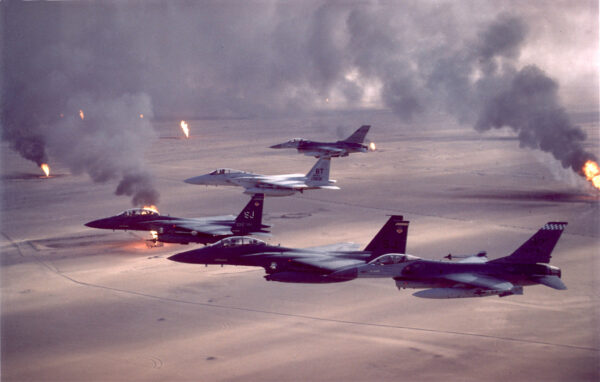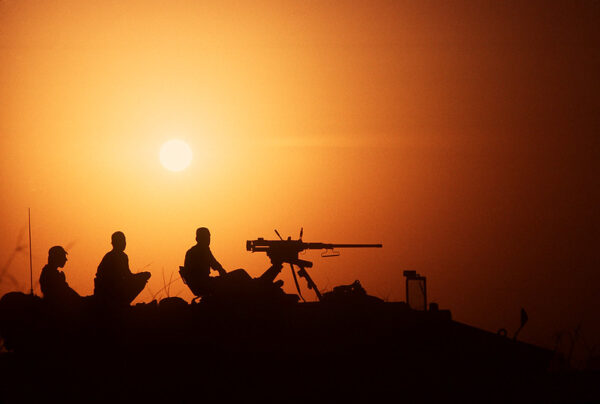
Operation Desert Storm began Jan. 15, 1991. (Photo: U.S. Air Force)
On Feb. 28, 1991, a coalition force led by the United States liberated Kuwait from Iraqi invaders, defeating one of the world’s largest militaries in days and returning the Persian Gulf to a state of relative peace.
Prelude to the Persian Gulf War
Mired in debt from the Iraq-Iran War, Iraqi leader Saddam Hussein invaded the oil-rich country of Kuwait in mid-to-late 1990, intending to eventually capture assets in Saudi Arabia as well.
Aug. 6–Jan. 17: The United Nations responds and Operation Desert Shield begins
The United Nations and the United States immediately condemned Iraq’s invasion. However, fearing a broadened conflict with global ramifications, military force was not the first option considered.
With regional and United Nations Security Council support, diplomatic efforts would continue in earnest through Jan. 15, 1991, at which point a coalition force could be dispatched to liberate Kuwait.
Meanwhile, at the request of Saudi Arabia, the United States began staging its forces on the Kuwaiti border to deter Iraq from pressing its invasion further. The move worked,
Hussein’s Iraq made some concessions on the diplomatic front, freeing western prisoners, for example, but never moved to retreat from Kuwait.
The United States and a U.N. Coalition join the Persian Gulf War
After Iraqi forces refused to pull out of Kuwait after a Jan. 5 United Nations deadline, the U.S.-led coalition moved to repel the Iraqi Military by force.
Jan. 17–Feb. 24: Operation Desert Storm begins with an overwhelming air campaign

(Photo: U.S. Air Force)
Iraq’s air force and air defenses proved wholly incapable of competing with the U.S.-led air force. Within a week, virtually all of Iraq’s invading air forces had either retreated or been destroyed — assuring air supremacy for allied forces.
Additionally, Iraq’s small navy was entirely defeated.
In retaliation, Iraq launched a series of largely unsuccessful SCUD missile attacks against U.S. ally Israel, possibly in hopes of expanding the conflict. At the strong urging of the United States and the United Nations, however, Israel refused to respond militarily and Coalition Forces in Kuwait were eventually able to destroy Iraq’s missile capabilities.
Feb. 24–Feb. 28: Operation Desert Sabre lands a decisive defeat on Iraqi ground forces

(Photo: Kentucky National Guard)
As ineffective as the Iraqi Air Force fared, the country’s ground forces performed far worse against the Coalition counterattack.
Deceptive tactics led Iraq to spread its forces thin in both Kuwaiti and Iraqi coastal territories. However, the actual Coalition invasion occurred elsewhere and at a lightning pace. Within 100 hours, 41 Iraqi infantry, mechanized, and armored divisions had been completely wiped out. Significantly more surrendered or fled. Meanwhile, U.S. and Coalition forces suffered comparatively minimal casualties.
In less than four days, Iraq was forced to accept a ceasefire.
Legacy of U.S. victory in the Persian Gulf War
While only 147 Americans were killed in action in the Persian Gulf War, considerably more suffered from long-term health effects likely caused by the Iraq Military’s destruction of Kuwaiti oil fields. It would take nearly three decades before comprehensive toxic exposure legislation would be passed.
In Iraq, Saddam Hussein remained in power following the war, and the remnants of the Iraqi military were largely allowed to remain intact. Tensions between Iraq, the rest of the Middle East, and the United States would remain high over the next decade, even briefly igniting additional military strikes against Iraqi targets associated with weapons of mass destruction in 1998.
Ultimately, these tensions would culminate in a second Iraq War in 2003.
To learn about more U.S. Military and veterans events, click here.













